Publications
Using Spherical Harmonics for Modeling Antenna Patterns
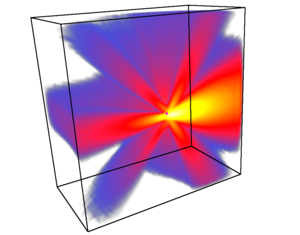
In radio wave propagation simulations there is a need for modeling antenna patterns. Both the transmitting and the receiving antenna influence the wireless link. We use spherical harmonics to compress the amount of measured data needed for complex antenna patterns. We present a method to efficiently incorporate these patterns into a ray tracing framework for radio wave propagation. We show how to efficiently generate rays according to the transmitting antenna pattern. The ray tracing simulation computes a compressed irradiance field for every point in the scene. The receiving antenna pattern can then be applied to this field for the final estimation of signal strength.
Efficient and Accurate Urban Outdoor Radio Wave Propagation
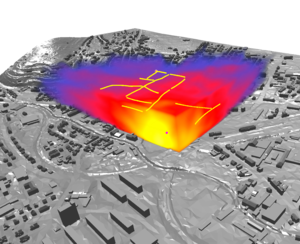
Simulating Radio Wave Propagation using geometrical optics is a well known method. We introduce and compare a simplified 2D beam tracing and a very general 3D ray tracing approach, called photon path tracing. Both methods are designed for outdoor, urban scenarios. The 2D approach is computationally less expensive and can still model an important part of propagation effects. The 3D approach is more general, and not limited to outdoor scenarios, and does not impose constraints or assumptions on the scene geometry. We develop methods to adapt the simulation parameters to real measurements and compare the accuracy of both presented algorithms.
Efficient Rasterization for Outdoor Radio Wave Propagation

Conventional beam tracing can be used for solving global illumination problems. It is an efficient algorithm, and performs very well when implemented on the GPU. This allows us to apply the algorithm in a novel way to the problem of radio wave propagation. The simulation of radio waves is conceptually analogous to the problem of light transport. We use a custom, parallel rasterization pipeline for creation and evaluation of the beams. We implement a subset of a standard 3D rasterization pipeline entirely on the GPU, supporting 2D and 3D framebuffers for output. Our algorithm can provide a detailed description of complex radio channel characteristics like propagation losses and the spread of arriving signals over time (delay spread). Those are essential for the planning of communication systems required by mobile network operators. For validation, we compare our simulation results with measurements from a real world network. Furthermore, we account for characteristics of different propagation environments and estimate the influence of unknown components like traffic or vegetation by adapting model parameters to measurements.
Simulation of Radio Wave Propagation by Beam Tracing

Beam tracing can be used for solving global illumination problems. It is an efficient algorithm, and performs very well when implemented on the GPU. This allows us to apply the algorithm in a novel way to the problem of radio wave propagation. The simulation of radio waves is conceptually analogous to the problem of light transport. However, their wavelengths are of proportions similar to that of the environment. At such frequencies, waves that bend around corners due to diffraction are becoming an important propagation effect. In this paper we present a method which integrates diffraction, on top of the usual effects related to global illumination like reflection, into our beam tracing algorithm. We use a custom, parallel rasterization pipeline for creation and evaluation of the beams. Our algorithm can provide a detailed description of complex radio channel characteristics like propagation losses and the spread of arriving signals over time (delay spread). Those are essential for the planning of communication systems required by mobile network operators. For validation, we compare our simulation results with measurements from a real world network.
Beam Tracing for Multipath Propagation in Urban Environments
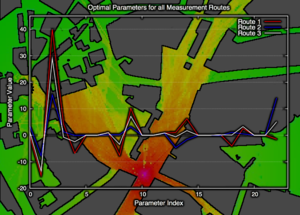
We present a novel method for efficient computation of complex channel characteristics due to multipath effects in urban microcell environments. Significant speedups are obtained compared to state-of-the-art ray-tracing algorithms by tracing continuous beams and by using parallelization techniques. We optimize simulation parameters using on-site measurements from real world networks. We formulate the adaption of model parameters as a constrained least-squares problem where each row of the matrix corresponds to one measurement location, and where the columns are formed by the beams that reach the respective location.
Wave Propagation Using the Photon Path Map
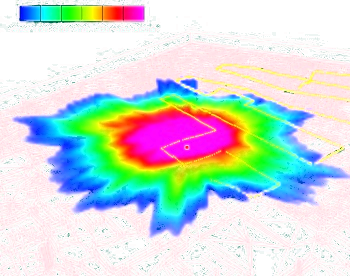
In wireless network planning, much effort is spent on the improvement of the network and transport layer -- especially for Mobile Ad Hoc Networks. Although in principle real-world measurements are necessary for this, their setup is often too complex and costly. Hence good and reliable simulation tools are needed. In this work we present a new physical layer simulation algorithm based on the extension and adaptation of recent techniques for global illumination simulation. By combining and improving these highly efficient algorithms from the field of Computer Graphics, it is possible to build a fast and flexible utility to be used for wireless network simulation. We compute a discrete sampling of the volumetric electromagnetic field by tracing stochastically generated photon paths through the scene. This so called Photon Path Map is then used to estimate the field density at any point in space and also provides local information about the delay spread. The algorithm can be applied to three dimensional indoor as well as outdoor scenarios without any changes and the path-tracing costs scale only logarithmically with the growing complexity of the underlying scene geometry.
The Effect of the Radio Wave Propagation Model in Mobile Ad Hoc Networks
The simulation of wireless networks has been an important tool for researchers and the industry in the last years. Especially in the field of Mobile Ad Hoc Networking, most current results have been achieved using simulators. The need for reproducible results and easy to observe environments limits the use of real world measurements for those kind of networks. It is stated here that the radio wave propagation model has a strong impact on the results of the simulation run. This work shows the limitations of current simulation environments and describes a high accuracy propagation model based on the use of a ray-tracer. By using a parallelized preprocessing step we made this propagation model feasible for usage in network simulators. Based on two examples, the effects on characteristic performance properties in Mobile Ad Hoc Networks are shown. We found that the physical layer simulation has a great impact on routing protocol efficiency.

